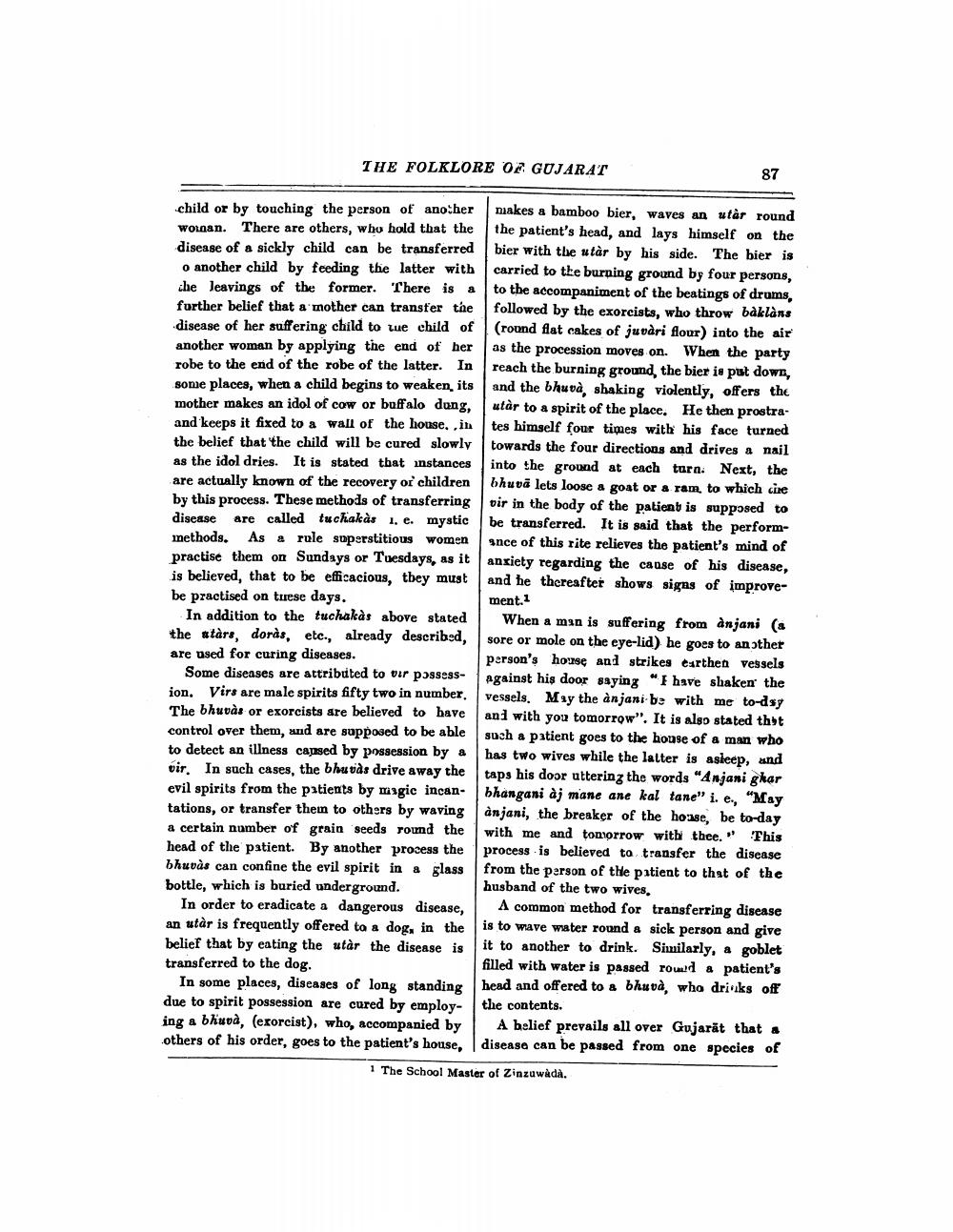________________
THE FOLKLORE OR GUJARAT
87
-
child or by touching the person of ano her woman. There are others, who hold that the disease of a sickly child can be transferred o another child by feeding the latter with che leavings of the former. There is a further belief that a mother can transfer the disease of her suffering child to lue child of another woman by applying the end of her robe to the end of the robe of the latter. In some places, when a child begins to weaken its mother makes an idol of cow or buffalo dung, and keeps it fixed to a wall of the house, ,in the belief that the child will be cured slowly as the idol dries. It is stated that instances are actually known of the recovery or children by this process. These methods of transferring disease are called tuchakàs 1. e. mystic methods. As a rule superstitious women practise them on Sundays or Tuesdays, as it is believed, that to be efficacious, they must be practised on tuese days.
In addition to the tuchakàs above stated the stars, doras, etc., already described, are used for curing diseases.
Some diseases are attributed to our possession, Virs are male spirits fifty two in number. The bhuvàs or exorcists are believed to bave control over them, and are supposed to be able to detect an illness caused by possession by a vir. In such cases, the bhuvas drive away the evil spirits from the patients by magic incantations, or transfer them to others by waving a certain number of grain seeds round the head of the patient. By another process the bhuvàs can confine the evil spirit in a glass bottle, which is buried underground.
In order to eradicate a dangerous disease, an utár is frequently offered to a dog, in the belief that by eating the utàr the disease is transferred to the dog.
In some places, diseases of long standing due to spirit possession are cured by employ- ing a bhuva, (exorcist), who, accompanied by others of his order, goes to the patient's house,
makes a bamboo bier, waves an utàr round the patient's head, and lays himself on the bier with the utàr by his side. The bier is carried to the burning ground by four persons, to the accompaniment of the beatings of drums, followed by the exorcists, who throw baklans (round flat cakes of juvdri flour) into the air as the procession moves on. When the party reach the burning ground, the bier is put down, and the bhuva, shaking violently, offers the utàr to a spirit of the place. He then prostrates himself four times with his face turned towards the four directions and drives a nail into the ground at each turn. Next, the bhuvā lets loose a goat or a ram, to which cire vir in the body of the patient is supposed to be transferred. It is said that the performsnce of this rite relieves the patient's mind of anxiety regarding the cause of his disease, and be thereafter shows signs of improvement.
When a man is suffering from anjani (a sore or mole on the eye-lid) he goes to another person's house and strikes earthen vessels against his door saying "I have shaken the vessels. May the anjani-be with me to-dsy and with you tomorrow". It is also stated thẠt such a patient goes to the house of a man who has two wives while the latter is asleep, and taps his door uttering the words "Anjani ghar bhangani aj mane ane kal tane" i. e., "May anjani, the breaker of the house, be to-day with me and tomorrow with thee. This process is believed to transfer the disease from the person of the patient to that of the husband of the two wives.
A common method for transferring disease is to wave water round a sick person and give it to another to drink. Similarly, a goblet filled with water is passed toward & patient's head and offered to a bhuva, who drisks off the contents.
A belief prevails all over Gujarat that a disease can be passed from one species of
1 The School Master of Zinzuwadà.




